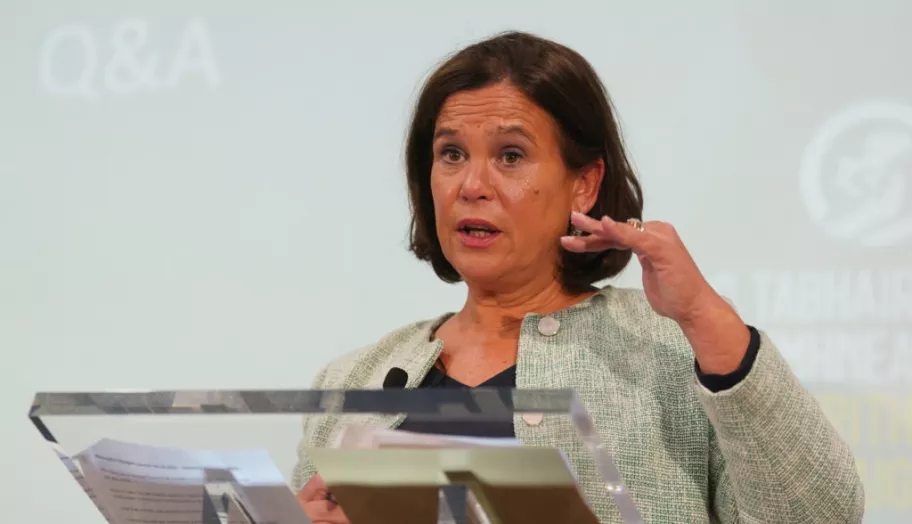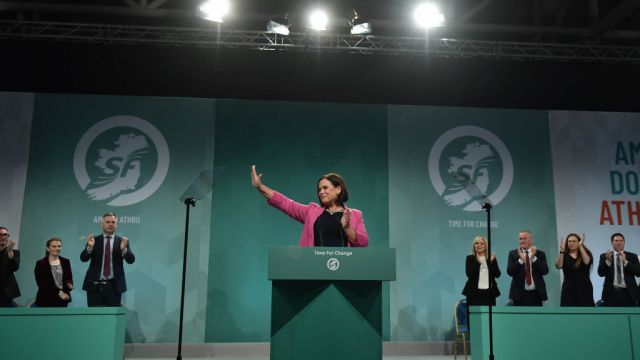The topic of housing has been one of, if not the biggest, political battlefields in recent years.
Rising house prices, rents and homeless figures arm opposition parties to take aim at the Coalition, and take aim they do.
However, last month, Taoiseach Leo Varadkar made a rare offer of advice to Sinn Féin leader Mary Lou McDonald, suggesting “there’s a transition you have to make from opposition to government, and a transition you have to make from minister to taoiseach”.
Condescending? Perhaps. But with Sinn Féin out in front on 25 per cent as per the last Red C poll, the party’s move to the driver’s seat is a distinct possibility.
If they hope to enter government after the next General Election, which must be held before March 2025, Sinn Féin can no longer focus on what they think the Government is doing wrong, it has to become about what they would do right if given the chance.
Here’s a look at the housing proposals Sinn Féin has put forward with an aim to increase supply and affordability.
What budget are they going to set aside for housing?
In its alternative budget for 2024, Sinn Féin placed a heavy focus on housing measures.
The party apportioned around €2.1 billion to cover current and capital expenditure, including funds for approved housing bodies and local government which are tied to housing but are classified as general government expenditure in the budget.
In addition to ramping up the supply of social and affordable housing, Sinn Féin said it would also speed up the planning process by increasing staff in An Bord Pleanála and in the wider planning system, at a cost of €13.2 million.
The alternative budget also included a rent return, which would see renters get back a month’s worth of rent, in addition to a three-year rent freeze, at a cost of €200 million for the year.

How many houses would they plan to build?
Sinn Féin’s alternative budget said the party build 21,000 social and affordable homes in 2024, at an additional cost of €1.4 billion.
The total figure was broken down into 13,000 social and 8,000 affordable housing units, up from the Government’s respective targets of 9,300 and 6,400 for the year, as laid out in the Housing For All plan.
The party’s housing spokesperson, Pearse Doherty, described the plan as “the biggest level of investment ever in the history of the State in terms of housing”.
The alternative budget also included €294 million for the provision of 1,000 turnkey social housing units, which the party said would be used to end homelessness among people aged over 55 within the year.
The party said these units would be delivered in 12 months “using emergency procurement and planning powers combined with new building technologies”.
According to the latest homeless figures from the Department of Housing, published on Friday, there were 199 people over the age of 65 who were recorded as homeless in December, and 2,636 people aged 45-65. As there was no further breakdown of the age distribution in the 45-65 cohort, it is unclear as to how many people aged over 55 were homeless at the last count.
What do they want to change in the existing system?
In addition to increasing the supply of social and affordable homes, Sinn Féin has proposed axing initiatives like the Help to Buy scheme.
The Coalition parties have jumped on this, criticising Sinn Féin for looking to do away with measures put in place to help first-time buyers get on the property ladder.
However, Sinn Féin argue that such schemes actually drive house prices up as they put more money into the housing market without tackling the key issue: demand.
By ending these initiatives, they say the money saved could instead be reallocated to funding more builds, or other measures which aim to drive home prices down across the board.
Separately, after the issue of investment funds bulk-buying residential properties bubbled to the surface again recently, Sinn Féin tabled a Private Members Motion, proposing an increase in Stamp Duty to disincentivise such purchases.
The Social Democrats had called for the duty to be increased from the current 10 per cent to 100 per cent to act as an “effective ban”.
While Sinn Féin’s motion only sought to increase it to a minimum rate of 17 per cent, it was still defeated in the Dáil.
What about bringing prices down?
In an interview last month, Sinn Féin leader Mary Lou McDonald outlined her party’s aim to “get prices as low as we feasibly can” if they were elected to govern, suggesting a target of €300,000 in Dublin.
But how? Well, it’s back to the age-old balancing act of supply versus demand.
This isn’t Sinn Féin-specific. Housing For All also puts increasing housing supply to its fore, because it’s understood that when housing is scarce, it drives up the price.
When there’s adequate supply, there’s less upward pressure on prices.
While there’s an agreed consensus that more homes must be built, the approach can differ.
For Sinn Féin, they’re saying they will deliver more state homes in a shorter time frame compared to the Government’s current targets.
Do we have the capacity to increase housing output?
Like we said, getting more supply into the housing market seems like the no-brainer in this equation, whether it be through new-builds or bringing vacant and derelict sites back into use.
However, that work requires workers, and plans to increase housing supply will fall at the wayside if the workers aren’t there to build them.
In the last Census in 2022, ‘construction of buildings’ was the eighth-largest industry. Just over 60,000 people over the age of 15 were recorded as working in the industry, while almost a further 25,000 were counted as working in ‘building completion and finishing’.
In contrast, in the 2006 Census, prior to the crash, the number of people over 15 noted as ‘building and construction workers’ was just shy of 183,500.
While it’s important to note that not all building and construction relates to housing, it does demonstrate how the industry remains smaller than it was during the boom, despite the growth of the Republic’s population.
Additionally, unemployment was recorded at 4.9 per cent last month, considered to be roughly full employment.
If more workers are needed to meet our housing goals, those in charge need to consider where we’re going to find them.

This could include initiatives for workers coming from overseas, training and upskilling for people looking to re-enter the workforce or change from their current occupation, and attracting more young people into careers in the industry through apprenticeships.
In its pre-budget submission last October, the Construction Industry Federation (CIF) said: “It is likely that additional employment is needed in the short term as the construction industry returns to pre-pandemic growth levels,” adding that the Government had predicted the “supply of available labour will expand more slowly than in the past”.
The CIF’s recommendations regarding labour focused on “investing in skill and maximising firm survival rates”, which it said could be achieved through the introduction of training and business supports.
The federation added that during periods of full employment in the State: “A unified approach that focusses on migration policy, labour activation policy and education and skills policy is needed to ensure continued productivity in the construction industry and the wider economy into the future.”
Are there any downsides to reducing house prices?
Let’s go back to Ms McDonald’s comments about bringing home prices down.
The Sinn Féin president said the party would aim to bring house prices within affordability, putting forward the €300,000 figure for Dublin, but adding there would be “regional variations on that”.
Sticking with Dublin, according to Daft.ie’s latest housing report, at the end of 2023, the average price of a home in the capital was €493,000.
But of course, as a median suggests, many homes in Dublin sold for far beyond that amount, particularly in certain parts of the city and county.
According to figures from the Central Statistics Office, in the year to November 2023, the median price of a dwelling in Dún Laoighaire-Rathdown was €622,000, the highest for any area in the State.
The gap between current or recent house prices in some parts of the country versus the “figure for affordability” put forward by Sinn Féin could be a problem for the party in winning over some voters.

For someone who recently purchased a home in Dún Laoighaire-Rathdown for something in the region of €600,000, the prospect of their investment devaluing because house prices are being driven down is a worrying thought.
It’s also something on which banks will be keeping a close eye, as they won’t want to give out loans for properties if political plans make it look like the collateral value of the property may take a hit.
Responding to Ms McDonald’s comments, Taoiseach Leo Varadkar said he was “a little bit taken aback”, warning the proposals would have “significant consequences”.
He claimed the move could push many homeowners into negative equity, and on the banking front, lenders may “think twice about issuing mortgages” and raise interest rates.
The Irish Property Owners Association (IPOA) said while it acknowledges the importance of addressing housing affordability, the group is “very concerned about the potential implications of the proposed drastic price reductions promoted by Sinn Féin”.
The IPOA’s chair, Mary Conway, warned “extreme measures can have unintended consequences”.
To make a careless statement of this magnitude before a general election will only serve to cause reverberations in the broader property market
While stating the group is committed to engaging with all political parties to explore effective solutions to the housing crisis, Ms Conway was critical of Ms McDonald’s comments on her party’s plans to reduce property prices.
“To make a careless statement of this magnitude before a general election will only serve to cause reverberations in the broader property market.
“Banks could restrict lending, homeowners might sell up and landlords could dispose of their stock, all moves that would cause a much more profound dysfunctionality in the housing market,” Ms Conway said.
So for the individual, how you may view Sinn Féin’s aim to reduce house prices will likely depend on where you stand (or don’t stand) on the property ladder.
If you’re a young person hoping to buy a home, lower residential property prices would be a welcome sight. If you’re someone who bought a property in recent years, or are about to buy a property, their proposal may be a worrying prospect.







